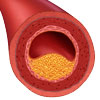Experimental drug safely boosts good cholesterol, lowers bad
An experimental drug raised levels of “good” HDL cholesterol while reducing the levels of “bad” LDL cholesterol – without elevating blood pressure, the reason for which the development of another drug in the same class was previously halted, according to late-breaking research presented at the American Heart Association’s Scientific Sessions 2011.
The study is simultaneously published in the Journal of the American Medical Association.
Evacetrapib was effective on lipid levels when used alone and also provided additional benefit when administered with other commonly prescribed cholesterol-lowering medications called statins.
The drug belongs to a new class of medications that blocks the ability of the enzyme cholesteryl ester transfer protein, or CETP, to transfer cholesterol particles from HDL to LDL, the latter being associated with the development of clogged arteries when present in excess. The more active CETP is in the bloodstream, the higher the LDL levels in the blood.
“There was considerable hope that CETP inhibitors would be the next big thing in heart disease treatment, but we had to go back to square one after torcetrapib caused excess deaths in a large clinical trial,” said Stephen J. Nicholls, M.D., Ph.D., lead researcher and cardiovascular director of the Cleveland Clinic Coordinating Center for Clinical Research in Ohio. “I think we now have a drug well characterised in terms of safety that would be worth testing in a big clinical trial to see if the changes in HDL and LDL provide benefit to the patients.”
The phase II trial involved 393 men and women, average age 59 years old, at 57 centres in the United States and Europe. In the 12-week study, patients took 30, 100 or 500 mg/day of evacetrapib alone.
Compared with patients taking a placebo, blood cholesterol results improved as the dose of evacetrapib increased:
- LDL levels fell 13.6 percent to 35.9 percent.
- HDL levels rose 53.6 percent to 128.8 percent.
- Levels of triglycerides, another blood fat linked to heart disease risk, fell 16 percent at the highest dose.
Furthermore, some patients taking 100 mg/day of evacetrapib also took commonly prescribed doses of various statins – either atorvastatin 20 mg/day, rosuvastatin 10 mg/day or simvastatin 40 mg/day. Among them, LDL levels fell and HDL levels rose significantly more than in patients taking the statins alone.
When investigators analysed the effects of evacetrapib in pre-specified subgroups of patients, they found it had a greater impact in those who were younger or started the trial with lower HDL or higher triglycerides.
“At the highest dose of evacetrapib, there was up to a 170 percent increase in HDL in patients with low levels,” Nicholls said. “This is very encouraging because these are the first patients we would think of treating with an HDL-raising medication.”
He said the drug had no significant effects on blood pressure and didn’t raise levels of aldosterone or cortisol, two chemicals that were elevated in the torcetrapib trial.
(Source: American Heart Association: Journal of the American Medical Association)
More information
 | For more information on cholesterol, including the health effects of high cholesterol and ways to lower cholesterol levels, as well as some useful tools, see Cholesterol. |
Dates
Tags
Created by:

 Login
Login














